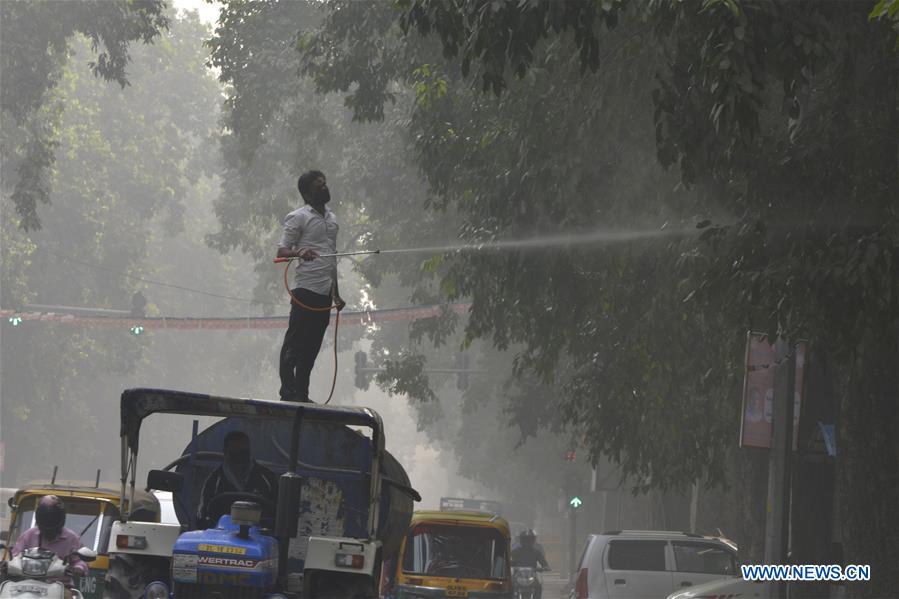By Rabi Sankar Bosu, Indian freelance contributor to Chinese media outlets
India's iconic white marvel, the Taj Mahal, meaning "Crown of the Palace," which is an ivory-white marble mausoleum built 369 years ago by Mughal Emperor Shah Jahan in memory of his beloved wife Mumtaz Mahal, has decayed in "all yellow" due to air pollution over the past 25 years.
According to a study led by University of Maryland published in the latest edition of journal Scientific Reports, India's emissions of the deadly human-made air pollutant Sulphur dioxide (SO2) increased by 50 per cent since 2007, while China's fell by 75 per cent. India is becoming, if not already, the world's top Sulphur dioxide emitter. The study should be a wake up call for India.

A municipal worker sprays water on the tree to settle dust as a measure against ongoing heavy pollution in the air in New Delhi, India on Nov. 9, 2017.(Xinhua/Sarkar)
India's capital New Delhi, home to nearly 19 million people, is the most polluted city on earth right now. Every year, during this time of year, Delhi transforms into a gas chamber for nearly two months. The air pollution has forced approximately 4,000 schools to close in New Delhi in the first week of November this year. On December 4-5, 2017, Sri Lankan cricketers wore masks during the third Test against India at Feroz Shah Kotla Stadium in Delhi. Such incidents prove India’s capital is suffering from an air quality nightmare that taunts the Twitter-loving Prime Minister Narendra Modi's "Clean India Mission."
Not only is the Indian capital struggling with noxious air but many other Indian cities face chronic pollution that has prompted criticisms on social media with unflattering headlines, "India and China both struggle with deadly pollution, but only one is fighting it" (Forbes, October 25, 2017). Apparently, India has paid scant attention to its deadliest air pollution.
The 2017 October report of the Lancet Commission on Pollution and Health found that India had the world's highest number of deaths due to air, water and other forms of pollution in 2015, which disproportionately affects the poor. Pollution should be deemed a serious health issue, rather than just an environmental problem.
Despite India disliking comparisons to its neighbor China, China remains miles ahead of India in reducing human-made air pollution, starting with the 2008 Summer Olympics. Since the launch of the clean air action plan in 2013, Beijing has implemented stiff measures to reduce air pollution.
On March 5, 2014, at the National People's Congress (NPC), Chinese Premier Li Keqiang declared "war" on pollution. He described smog as "nature's red-light warning against inefficient and blind development." China's systematic efforts to combat air, water and soil pollution have achieved remarkable results in limiting particle matter (PM2.5), echoing President Xi Jinping’s vow to fight pollution with an "iron hand."
Meanwhile, pollution levels have kept rising in India. It was reported that air pollution in New Delhi three weeks ago was 10 times worse than Beijing's at the same period. Beijing looks more serious in combating smog to get its AQI (air quality index) levels down to breathable levels.
According to Xinhua, Delhi's average annual hazardous fine particle matter (PM2.5) concentrations stood at 150 μg/m, compared to about 58 μg/m for Beijing. Beijing is eliminating coal-fired boilers and upgrading gas-fired boilers with low nitrogen combustion technology. Since 2013, about 900,000 households in 2,036 villages have shifted from coal to clean energy, cutting the use of coal by 2.7 million tons per year. 338 Chinese cities monitored by the Ministry of Environmental Protection (MEP) reported good air quality on 87.8 percent during October, down by 5 percentage points from the same period last year.
As environment protection has become a key issue faced by all people, China has developed an ecological civilization to build a beautiful China. Beijing aims to strike a balance between human and nature to make notable achievements in reducing pollution by 2020, as well as to garner fundamental improvements in its ecology by 2035.
Xi has placed top priority on cleaning up smoggy skies, dirty rivers and intoxicated soils, since "lucid waters and lush mountains are invaluable assets." The Chinese government has vowed to bring back blue skies to Beijing.
While China continues to enact strict policies to limit air pollution, India has not taken any concrete measures to clear its chocking smog. Despite being a major source of energy in China, coal-fired power plants and steel factories have come under the hammer. Beijing has implemented the world's largest clean coal-fired power generation system over the past five years by completing the "ultra-low emission" transformation of coal-fired power plants with combined capacity of 640 million kilowatts, 68 percent of the country's total installed capacity of coal-fired generating units. The transformation has resulted in 83 percent decrease in sulfur dioxide emission, 50 percent cut in nitrogen oxides, and 67 percent reduction in smoke dust.
Yet, India opened its largest coal-fired power plant in 2012 and has not enacted emission controls similar to China. When the world is undergoing an energy transition, with the target to connect 40 million households to the grid by December 2018 and curb rising electricity prices, India has invested heavily in coal mines.
In recent years, the Chinese government has placed emphasis on clean energy and the biggest investor in renewable energy. Hydro, wind, solar and nuclear energy accounted for 20 per cent of the country's total energy consumption in 2016, up from 14.5 per cent in 2012. Beijing plans to end the production and sale of gas, diesel-powered vehicles entirely as part of its efforts to reduce pollution and carbon emissions. The Chinese government fixes the number of cars on the road. China is rolling out green transport to reduce transport-related emission, promoting excavation technology and electric cars.
China stands way ahead of India in the realm of sustainable, green development such as clean air, safe water, sewage management, and green areas in cities. The Indian government appears partially responsible for delaying progress in environmental protection. India should learn from China. Indian politicians need to look at how China handles the situation in various forms when air pollution gets worse.
(The opinions expressed here do not necessarily reflect the opinions of Panview or CCTV.com. )

Panview offers a new window of understanding the world as well as China through the views, opinions, and analysis of experts. We also welcome outside submissions, so feel free to send in your own editorials to "globalopinion@vip.cntv.cn" for consideration.
















